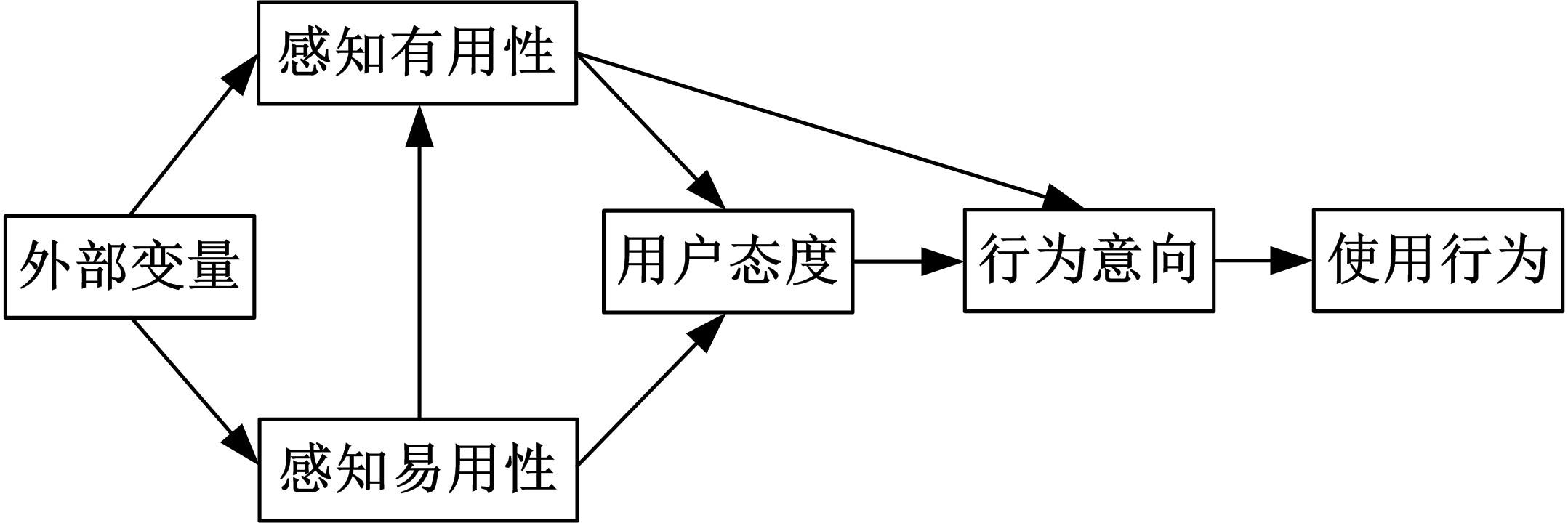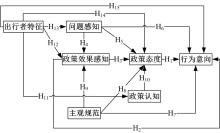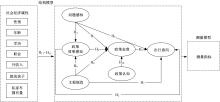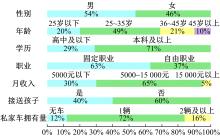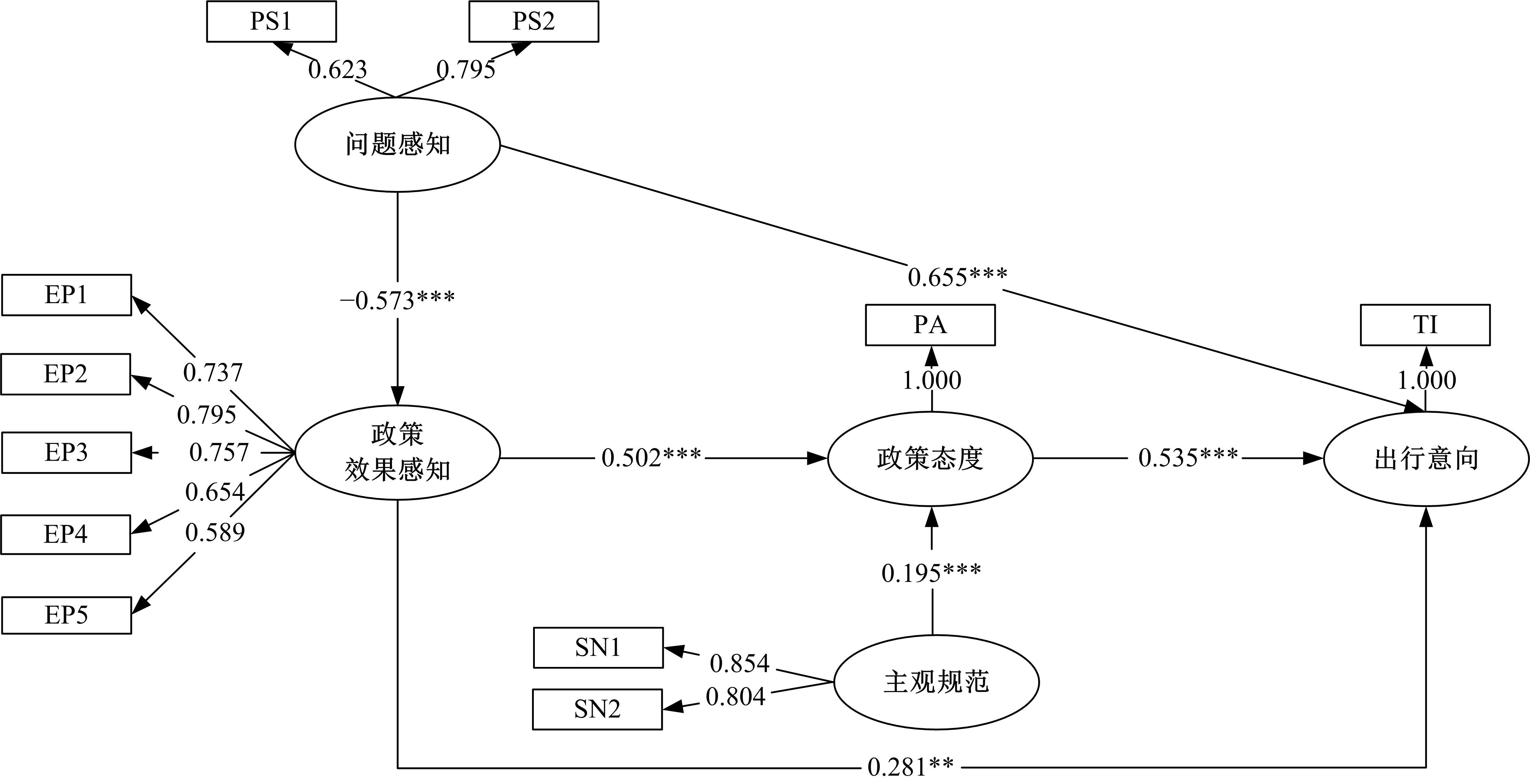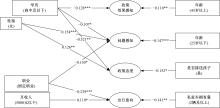吉林大学学报(工学版) ›› 2022, Vol. 52 ›› Issue (11): 2607-2617.doi: 10.13229/j.cnki.jdxbgxb20210388
• 交通运输工程·土木工程 • 上一篇
限行政策下城市居民低碳出行意向
- 1.长安大学 运输工程学院,西安 710064
2.山东省交通规划设计院集团有限公司,济南 250031
Urban residents' low⁃carbon travel intention after implementation of driving restriction policy
Zhuang-lin MA1( ),Shan-shan CUI2,Da-wei HU1
),Shan-shan CUI2,Da-wei HU1
- 1.College of Transportation Engineering,Chang'an University,Xi'an 710064,China
2.Shandong Provincial Communications Planning and Design Institute Group Co. ,Ltd. ,Jinan 250031,China
摘要:
为探究限行政策下影响城市居民低碳出行意向的因素及其相互作用机理,本文以计划行为理论和技术接受模型为基础,采用多指标多原因(MIMIC)模型构建了限行政策下城市居民低碳出行意向模型。采用行为偏好调查方法设计调查问卷,通过网络调查和现场调查获得637份有效样本,运用MIMIC模型进行实证检验。研究结果表明:政策态度、政策效果感知和问题感知对出行意向有直接的显著影响;政策态度和政策效果感知是中介变量,政策效果感知、主观规范通过影响政策态度进而影响出行意向,问题感知通过影响政策效果感知进而影响出行意向;潜在变量对限行后居民的低碳出行意向影响的总效应值从大到小依次排序为:政策效果感知、政策态度、问题感知、主观规范;社会经济属性是调节变量,能通过调节出行者的心理感知因素间接影响出行意向。研究结论可为交通管理部门提高限行政策效益、引导居民低碳出行提供理论支撑。
中图分类号:
- U491
| 1 | Grange L D, Troncoso R. Impacts of vehicle restrictions on urban transport flows: the case of Santiago, Chile[J]. Transport Policy, 2011, 18(6): 862-869. |
| 2 | Yang Y L, Guo Y Y, Luo S Q. Consumers' intention and cognition for low-carbon behavior: a case study of Hangzhou in China[J]. Energies, 2020, 13(21): 1-19. |
| 3 | Fishbein M, Belief Ajzen I., Attitude, Intention and Behavior : an Introduction to Theory and Research[M]. Massachusetts: Addison-Wesley Publishing Company, 1975. |
| 4 | Hu X J, Wu N, Chen N. Young people's behavioral intentions towards low-carbon travel: extending the theory of planned behavior[J]. International Journal of Environmental Research and Public Health, 2021, 18(5): 18052327. |
| 5 | Schuitema G, Steg L, Forward S. Explaining differences in acceptability before and acceptance after the implementation of a congestion charge in Stockholm[J]. Transportation Research Part A: Policy and Practice, 2010, 44(2): 99-109. |
| 6 | Gu Z, Liu Z, Cheng Q, et al. Congestion pricing practices and public acceptance: a review of evidence[J]. Case Studies on Transport Policy, 2018, 6(1): 94-101. |
| 7 | Schade J, Schlag B. Acceptability of urban transport pricing strategies[J]. Transportation Research Part F: Traffic Psychology and Behavior, 2003, 6(1): 45-61. |
| 8 | Geng J C, Long R Y, Chen H, et al. Exploring the motivation-behavior gap in urban residents' green travel behavior: a theoretical and empirical study[J]. Resources Conservation & Recycling, 2017, 125: 282-292. |
| 9 | Vos J D, Witlox F. Travel satisfaction revisited, on the pivotal role of travel satisfaction in conceptualising a travel behaviour process[J]. Transportation Research Part A: Policy and Practice, 2017, 106: 364-373. |
| 10 | Gaunt M, Rye T, Allen S. Public acceptability of road user charging: the case of edinburgh and the 2005 referendum[J]. Transport Reviews, 2007, 27(1): 85-102. |
| 11 | Eriksson L, Garvill J, Nordlund A M. Acceptability of travel demand management measures: the importance of problem awareness, personal norm, freedom, and fairness[J]. Journal of Environmental Psychology, 2006, 26(1): 15-26. |
| 12 | Khademi E, Timmermans H. The long-term effectiveness of a reward scheme in changing daily travel choices[J]. Procedia Social & Behavioral Sciences, 2014, 111: 380-389. |
| 13 | Gärling T, Schuitema G. Travel demand management targeting reduced private car use: effectiveness, public acceptability and political feasibility[J]. Journal of Social Issues, 2010, 63(1): 139-153. |
| 14 | Jia N, Zhang Y D, He Z B, et al. Commuters' acceptance of and behavior reactions to license plate restriction policy: a case study of Tianjin, China[J]. Transportation Research Part D: Transport and Environment, 2016, 52: 428-440. |
| 15 | 温旭丽, 杨悦, 叶欣. 大城市居民出行轨道交通选择意向研究[J]. 公路交通科技: 应用技术版, 2012(8): 356-359. |
| Wen Xu-li, Yang Yue, Ye Xin. Study on urban residents' choice of rail transit in big cities[J]. Journal of Highway and Transportation Search and Development(Application Technology Edition), 2012(8): 356-359. | |
| 16 | 颜冉, 储金龙, 杨新刚. 城市居民使用共享单车意向研究——以合肥为例[J]. 交通信息与安全, 2017, 35(6): 101-107, 114. |
| Yan Ran, Chu Jin-long, Yang Xin-gang. Intention of urban residents to use public bike sharing system: a case study in hefei[J]. Journal of Transport Information and Safety, 2017, 35(6): 101-107, 114. | |
| 17 | Liu Y X, Hong Z S, Liu Y. Do driving restriction policies effectively motivate commuters to use public transportation?[J]. Energy Policy, 2016, 90: 253-261. |
| 18 | 侯现耀,陈学武.基于态度的公交出行信息使用市场细分[J].吉林大学学报:工学版,2018,48(1): 98-104. |
| Hou Xian-yao, Chen Xue-wu. Use of public transit information market segmentation based on attitudinal factors[J]. Journal of Jilin University(Engineering and Technology Edition), 2018, 48(1): 98-104. | |
| 19 | 刘宇峰, 钱一之, 胡大伟, 等. 基于结构方程模型的不同规模城市居民出行方式选择影响因素的关联性分析[J]. 长安大学学报: 自然科学版, 2018, 38(5): 93-101. |
| Liu Yu-feng, Qian Yi-zhi, Hu Da-wei, et al. Correlation analysis of travel mode choice for urban residents in different urban size based on structural equation model[J]. Journal of Chang'an University(Natural Science Edition), 2018, 38(5): 93-101. | |
| 20 | Bollen A. Structural Equations with Latent Variables[M]. New York: John Wiley & Sons Inc., 1989. |
| 21 | Allen J, Bellizzi M G, Eboli L, et al. Service quality in a mid-sized air terminal: a SEM-MIMIC ordinal probit accounting for travel, sociodemographic, and user-type heterogeneity[J]. Journal of Air Transport Management, 2020, 84: 101780. |
| 22 | Ingvardson J B, Nielsen O A. The relationship between norms, satisfaction and public transport use: a comparison across six european cities using structural equation modelling[J]. Transportation Research Part A: Policy and Practice, 2019, 126: 37-57. |
| 23 | 舒诗楠, 边扬, 荣建, 等. 短距离下小汽车出行向自行车出行转移意向MIMIC模型[J]. 北京工业大学学报, 2019, 45(10): 998-1008. |
| Shu Shi-nan, Bian Yang, Rong Jian, et al. Transition from driving to bicycling in short-distance travel based on MIMIC model[J]. Journal of Beijing University of Technology, 2019, 45(10): 998-1008. | |
| 24 | Zailani S, Iranmanesh M, Masron T A, et al. Is the intention to use public transport for different travel purposes determined by different factors?[J]. Transportation Research Part D: Transport and Environment, 2016, 49: 18-24. |
| 25 | 胡松, 翁剑成, 周伟, 等. 基于扩展计划行为理论的公共交通出行依赖性影响[J]. 吉林大学学报: 工学版, 2022, 52(5): 1037-1044. |
| Hu Song, Weng Jian-cheng, Zhou Wei, et al. Influence of travelers' dependence on public transportation based on extended theory of planning behavior[J]. Journal of Jilin University(Engineering and Technology Edition), 2022, 52(5): 1037-1044. | |
| 26 | Chen S Y. Green helpfulness or fun?Influences of green perceived value on the green loyalty of users and non-users of public bikes[J]. Transport Policy, 2016, 47: 149-159. |
| 27 | 齐航, 夏嘉祺, 王光超, 等.考虑出行者习惯与利他性偏好的自动驾驶网约车使用意向模型[J]. 交通运输工程与信息学报, 2021, 19(2): 1-10. |
| Qi Hang, Xia Jia-qi, Wang Guang-chao, et al. A behavioral intention to use model of autonomous vehicle ride-hailing incorporating traveler habit and altruistic preference[J]. Journal of Transportation Engineering and Information, 2021, 19(2): 1-10. | |
| 28 | 王月辉,梁江伟,范实,等.基于技术接受模型(TAM)的网约车出行意向影响因素研究[C]∥第十九届中国管理科学学术年会, 南京,中国, 2017: 694-700. |
| 29 | Chen C F, Chao W H. Habitual or reasoned?using the theory of planned behavior, technology acceptance model, and habit to examine switching intentions toward public transit[J]. Transportation Research Part F: Traffic Psychology and Behavior, 2011, 14(2): 128-137. |
| 30 | Chen S Y. Using the sustainable modified TAM and TPB to analyze the effects of perceived green value on loyalty to a public bike system[J]. Transportation Research Part A: Policy and Practice, 2016, 88: 58-72. |
| 31 | Ajzen I. The theory of planned behavior[J]. Organizational Behavior and Human Decision Processes, 1991, 50(2): 179-211. |
| 32 | Davis F D, Bagozzi P R, Warshaw P. User acceptance of computer technology: a comparison of two theoretical models[J]. Management Science, 1989, 35(8): 982-1003. |
| 33 | Schlag B, Teubel U. Public acceptability of transport pricing[J]. IATSS Research, 1997, 21(2): 134-142. |
| 34 | 罗艳菊, 黄宇, 毕华, 等. 基于环境态度的城市居民环境友好行为意向及认知差异——以海口市为例[J]. 人文地理, 2012, 27(5): 75-81. |
| Luo Yan-ju, Huang Yu, Bi Hua, et al. Difference in urban residents' pro-environmental behavior intention and understanding based on their environmental attitude a case study of haikou[J]. Human Geography, 2012, 27(5): 75-81. | |
| 35 | Nico D, Yue B, Meng X, et al. Acceptability of a tradable driving credit scheme in the Netherlands and Beijing[J]. Case Studies on Transport Policy, 2018, 6(4): 499-509. |
| 36 | Rentziou A, Milioti C, Gkritza K, et al. Urban road pricing: modeling public acceptance[J]. Journal of Urban Planning & Development, 2011, 137(1): 56-64. |
| 37 | 和占琼, 姜玉婷, 何明卫. 城市通勤者低碳出行选择研究——基于TPB与VBN整合模型[J]. 干旱区资源与环境, 2019, 33(4): 89-95. |
| He Zhan-qiong, Jiang Yu-ting, He Ming-wei. Study on urban low carbon travel choice based on TPB and VBN integration model[J]. Journal of Arid Land Resources and Environment, 2019, 33(4): 89-95. | |
| 38 | 吴文静, 景鹏, 贾洪飞, 等. 基于K均值聚类与随机森林算法的居民低碳出行意向数据挖掘[J]. 华南理工大学学报: 自然科学版, 2019, 47(7): 105-111. |
| Wu Wen-jing, Jing Peng, Jia Hong-fei, et al. Low carbon travel intention data mining for residents based on K-means clustering and random forest algorithm[J]. Journal of South China University of Technology (Natural Science Edition), 2019, 47(7): 105-111. |
| [1] | 方松,马健霄,李根,沈玲宏,徐楚博. 城市快速路右侧车道移动作业区行车风险分析[J]. 吉林大学学报(工学版), 2022, 52(8): 1786-1791. |
| [2] | 宋现敏,杨舒天,刘明鑫,李志慧. 站点间公交行程时间波动特性及预测方法[J]. 吉林大学学报(工学版), 2022, 52(8): 1792-1799. |
| [3] | 张玮,张树培,罗崇恩,张生,王国林. 智能汽车紧急工况避撞轨迹规划[J]. 吉林大学学报(工学版), 2022, 52(7): 1515-1523. |
| [4] | 郑植,耿波,王福敏,董俊宏,魏思斯. 既有低等级混凝土护栏防护能力提升[J]. 吉林大学学报(工学版), 2022, 52(6): 1362-1374. |
| [5] | 吴文静,战勇斌,杨丽丽,陈润超. 考虑安全间距的合流区可变限速协调控制方法[J]. 吉林大学学报(工学版), 2022, 52(6): 1315-1323. |
| [6] | 徐洪峰,陈虹瑾,张栋,陆千惠,安娜,耿现彩. 面向网联汽车环境的单点全感应式信号配时技术[J]. 吉林大学学报(工学版), 2022, 52(6): 1324-1336. |
| [7] | 盖松雪,曾小清,岳晓园,袁子豪. 基于用户-系统双层优化算法的车位引导模型[J]. 吉林大学学报(工学版), 2022, 52(6): 1344-1352. |
| [8] | 李先通,全威,王华,孙鹏程,安鹏进,满永兴. 基于时空特征深度学习模型的路径行程时间预测[J]. 吉林大学学报(工学版), 2022, 52(3): 557-563. |
| [9] | 冯天军,孙学路,黄家盛,田秀娟,宋现敏. 基于三种过街方式的两相位信号交叉口延误[J]. 吉林大学学报(工学版), 2022, 52(3): 550-556. |
| [10] | 李兴华,冯飞宇,成诚,王洧,唐鹏程. 网约拼车服务选择偏好分析及建模[J]. 吉林大学学报(工学版), 2022, 52(3): 578-584. |
| [11] | 尹超英,邵春福,黄兆国,王晓全,王晟由. 基于梯度提升决策树的多尺度建成环境对小汽车拥有的影响[J]. 吉林大学学报(工学版), 2022, 52(3): 572-577. |
| [12] | 贾洪飞,邵子函,杨丽丽. 终点不确定条件下网约车合乘匹配模型及算法[J]. 吉林大学学报(工学版), 2022, 52(3): 564-571. |
| [13] | 马洁,黄家骏,田俊,董杨慧. 地铁车站换乘通道内乘客疏散的目标决策行为建模[J]. 吉林大学学报(工学版), 2022, 52(11): 2600-2606. |
| [14] | 汪怡然,陈景旭,王岳平,霍锦彪,刘志远. 考虑服务公平性的定制公交动态响应方案[J]. 吉林大学学报(工学版), 2022, 52(11): 2574-2581. |
| [15] | 吴静娴,申华鹏,韩印,杨敏. 考虑城市建成环境非线性作用的通勤时间模型[J]. 吉林大学学报(工学版), 2022, 52(11): 2568-2573. |
|
||



